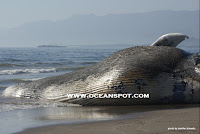
Japan is Still Hunting Whales
Although Japan agreed to halt their hunt of Humpback whales on December 19, 2007, they are still actively hunting both Minke and Fin whales. They intend to kill 935 Minke whales and 50 endangered Fin whales under the guise of "scientific" whaling. Although a worldwide moratorium on whale killing was enacted in 1986, Japan, Norway and Iceland have turned their backs on this international agreement and intend to kill over 3,000 whales in 2008. If you have ever been lucky enough to see whales in the wild, it's hard to fathom that they are still the targets of hunters. The methods of modern whale hunting are brutal and the whales usually die a very slow and painful death.
There are many ways you can take action to help the whales. Here are a few:
1. Contact your congressional representative to voice your opinion. The Pacific Whale Foundation has step-by-step instructions on how to contact your representative as well as text that can be copied/pasted/edited and then e-mailed. Click this link and scroll to the bottom of the page for further details. They also have a printable PDF page that you can use to collect signatures and mail to the president.
2. Donate to organizations such as the International Fund for Animal Welfare or volunteer some of your time with a local organization.
3. Consider where you spend your tourist dollars. Before planning travel to Japan, Norway, or Iceland think about whether you want to spend your hard-earned money in such countries while they are still killing whales. If you do decide to move forward with your travel, consider contacting the consulates of Japan, Norway, or Iceland to express your opinion on their whale-hunting practices.



















